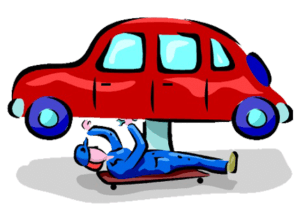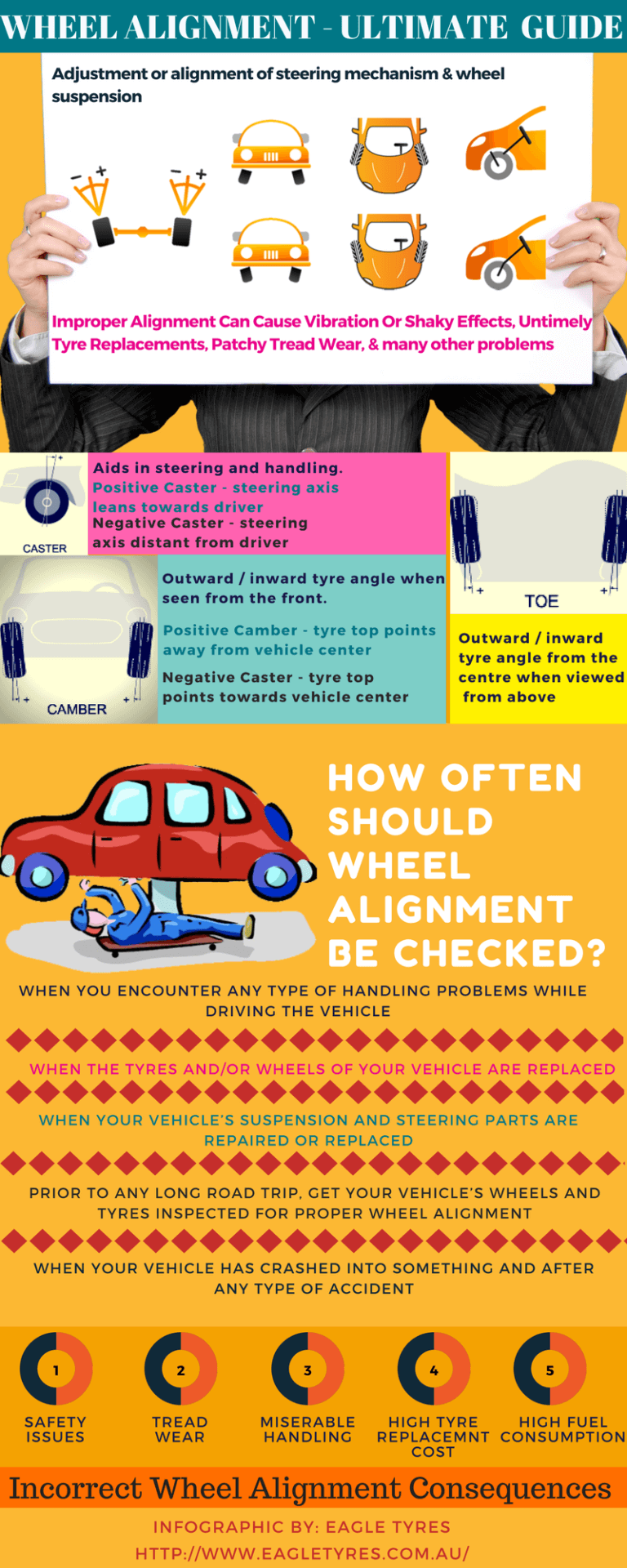When the wheels of your car are aligned properly, you can control it the way you want it – True! Wheel alignment (aka tire alignment), is the adjustment or alignment of the steering mechanism and wheel suspension of your vehicle. Wheel Alignment is an indispensable part of your vehicle’s wheel service. A variety of unruly events can cause wheels and tyres to lose alignment such as minor accidents, road conditions including your driving habits.
THE CRUX OF WHEEL ALIGNMENT

If your tyres and wheels are asymmetrical, varied problems can add up in your vehicle’s mechanical systems. In case, your car’s wheel alignment isn’t right then your vehicle will pull towards the right or the left on releasing the steering wheel while you’re driving. Additionally, you may also sense vibration or shaky effect, particularly in your steering wheel. Furthermore, misalignment is one of the major reasons of an untimely tyre replacement or patchy tread wear. The right wheel alignment facilitates safe driving and prolongs the life of your vehicle’s tyres.
WHEN IS A WHEEL ALIGNMENT REQUIRED?
As per experts’ recommendations, when you have a new set of tyres fixed to your vehicle, you should perform the alignment of your tyres. As wheels and tyres are a part of a complex suspension system, you should have a licensed technician to get your vehicle cleared to make sure your ride conforms to the safety and performance norms.
Typically, three angles are commonly checked during a wheel alignment service in Sydney and they are:
A. CASTER ANGLE
Caster angle aids in steering and handling the vehicle. If the steering axis leans towards the driver when viewed from the vehicle’s side then it’s a positive caster and when the axis is distant from the driver then it’s the negative caster.
B. CAMBER ANGLE
The outward and inward angle of the tyre is the camber when seen from the front of the vehicle. It’s known as negative camber when the top of the tyre points towards the centre of the vehicle. It’s known as positive camber when the top of the tyre points away from the centre of the vehicle. This is the reason inside or outside edge of the tyre wears sooner than normal. While driving, the vehicle gets pulled in one direction due to the extreme difference in the camber angle.
C. TOE ANGLE
The inward and outward angle of the tyre from the centre of the car is the toe angle when viewed from above. The right toe alignment facilitates the vehicle to drive straight and assists vehicle’s stability.
INCORRECT WHEEL ALIGNMENT CONSEQUENCES
A. SAFETY CONCERN
The safety of road commuters is endangered due to vehicle’s improper alignment. Tyres are one of the central components of a car and the system to which they are connected. Tyres should be rightly aligned to maximise a vehicle’s handling features.
B. TREAD WEAR INCREASES
Tyres that are not properly aligned wears faster than correctly aligned ones. Incorrect alignment normally causes tyres to have extreme edge wear, which affects vehicle’s braking distance and road grip.
C. MISERABLE HANDLING
A vehicle tends to lose its grip on the roads when the wheel alignment is not right. While driving, the vehicle tends to pull in one direction, thus, driving becomes all the more difficult with any alignment issues. A vehicle becomes less stable during wet weather conditions when the roads are wet, increasing the risk of road accidents.
D. TYRE REPLACEMENT COST INCREASES
With incorrect wheel alignment, the need to change tyres increases because it causes extreme tyre wear. In the process of driving on the tyres that are incorrectly aligned, the tread material also gets damaged.
E. FUEL CONSUMPTION SHOOTS UP
Due to an incorrect wheel alignment, when there is a constant drag on the uneven tyre, the vehicle’s input in terms of braking, the steering and handling are impacted that increases the cost of the fuel.
HOW OFTEN SHOULD WHEEL ALIGNMENT BE CHECKED?

Ideally, wheel alignment should be annually checked but it also depends on the number of kilometres the vehicle has travelled. Other indicators that could aid in determining the right time to give a visit to your local certified mechanic include:
- When you encounter any type of handling problems while driving the vehicle such as you feel the steering is quite hard to manoeuvre while making a turn or the vehicle is getting pulled to one direction?
- When the tyres and/or wheels of your vehicle are replaced?
- When your vehicle’s suspension and steering parts are repaired or replaced?
- Prior to any long road trip, get your vehicle’s wheels and tyres inspected for proper wheel alignment in Sydney.
- When your vehicle has crashed into something and after any type of accident?
SUMMING UP
Road safety is the major concern among the vehicle manufacturers. With the immense competition and advancement in the tyre and wheel industry, every major tyre & wheel manufacturer is offering its finest tyres and wheels for sale. Tyres and wheels are evaluated on the basis of tread pattern and shoulder blocks as well as durability and in-house technologies for effective handling and traction.
Eagle Tyres is the premier wheel shop in Sydney and uses only the latest equipment having advanced technology, which is updated and fine-tuned on a regular basis, so you can be rest assured that your vehicle’s wheel alignment will be performed fittingly.
A WHEEL ALIGNMENT INFOGRAPHIC TO GIVE YOU THE GIST OF THE BLOG






